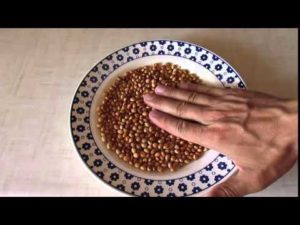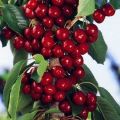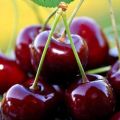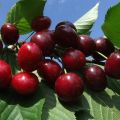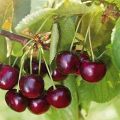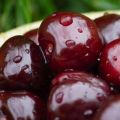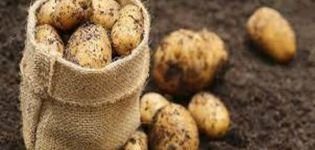Description and characteristics of the Rossoshanskaya gold cherry variety, cultivation
Cherry Rossoshanskaya is subdivided into gold, large and black. Gold has a bright yellow color and a pleasant sweet taste. This variety is resistant to low temperatures and drought. It gives a lot of harvest, has a low size and a pyramidal crown. The plant is unpretentious in care, but requires preventive measures to combat pests.
The history of breeding cherry Rossoshanskaya gold
The Rossoshansk cherry variety was bred in Voronezh at the Rossoshansk experimental station. Work on the fruit crop was carried out by A. Ya. Vorochikhina. At the moment it is not included in the State Register, but it was previously included. Many gardeners grow it.
Advantages and disadvantages: is it worth planting on the site
Sweet cherry Rossoshanskaya gold has the following advantages:
- High productivity.
- High resistance to drought.
- Frost resistance.
- Good fruit quality.
- Low growth, making it easy to harvest.
The disadvantages include:
- The need for a pollinator neighbor.
- Susceptibility to disease and pests.
- Unwanted neighborhood with some cultures.
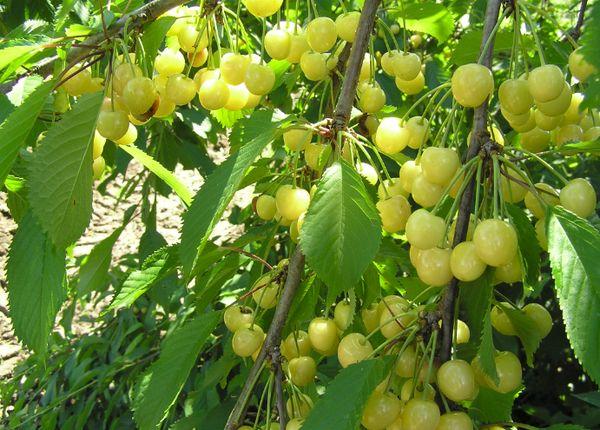
Varieties of cultures
Rossosh cherry is subdivided into three subspecies: large, black, golden.
Large
Has large berries, each weighing 6.7 grams, maroon color. The shape is rounded, slightly flattened at the sides. The tree is low, with a lush crown. During the flowering period, forms large lush white flowers. It takes root in the North Caucasus region.
Black
A tree with a maximum height of 3 m. Lush crown, tight-fitting leaves, especially on young twigs. The color of the berries is almost black, with a red tint. Rounded berries, medium, sweet taste. They are distinguished by good transportability due to their dense skin.
Gold
The tree is not tall and makes it easy to harvest. The berries are large, golden in color. If the trees are well lit, they will produce berries with a pink tint. Cherry blossoms with lush white flowers.
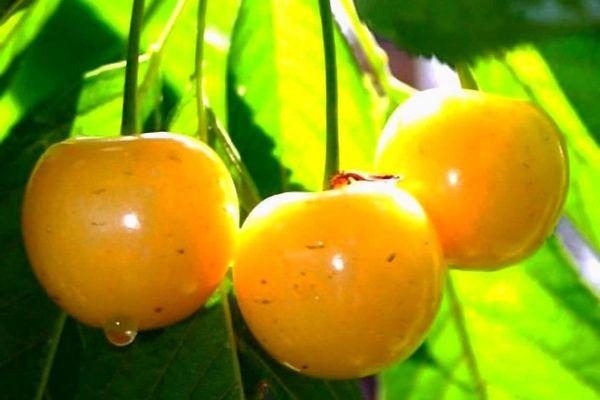
Brief description of the variety
The cherry reaches a height of 3 meters, the crown grows in the form of a pyramid, the foliage is not very dense.The fruits are large, about 50 berries are tied on one branch. The leaves are elongated, lanceolate, green or dark green. Berries are yellow or yellow with a pink tinge, large. They have a sweet taste, dense skin.
Height and branching of the crown
The maximum tree height is 3 meters. Due to this size, fruits are easily harvested. Spreading crown in the form of a pyramid. Forms large, long branches towards the bottom of the tree, shorter branches towards the top.
Pollinating varieties, flowering and fruiting
Sweet cherry Rossoshanskaya gold self-fertile. To set buds, she needs pollinating neighbors. The flowering periods of these plants must match. The following types are suitable:
- Wonder cherry;
- Night;
- Leningrad cherry;
- Check mark;
- Ovstuzhenka.
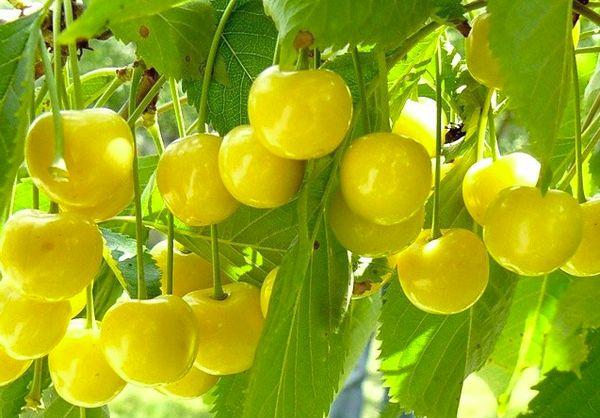
In the 4-5th year of the vegetative period, the sweet cherry begins to bear fruit. The lifespan of the variety is 25 years. Ovaries that form before this date will not bear fruit.
The tree starts flowering early - in mid-April. With the onset of night frosts at this time, the yield decreases. Lush, large, white flowers are formed. Each flower consists of 5 petals, they form dense inflorescences of 10-15 pieces. The fruiting period is average, the berries ripen by mid-June or early July. They have dense cuttings, which reduces berry shedding.
Important! If a pollinator does not grow next to the Rossosh cherry, then the tree will not be able to set fruits after flowering.
Transportability and scope of berries
Thanks to their strong skin, the berries tolerate moving and storage well. They are consumed fresh. Used for making stewed fruit, preserves, jams, freezing. This variety is grown to be sold in large quantities to the market.
Specifications
Sweet cherry has good characteristics for planting in open ground. Easily copes with low temperatures and drought, but immunity is not the most resistant.
Resistant to freezing temperatures and drought
This cherry variety easily tolerates low temperatures and drought. The tree has a strong root system, which allows it to get water from deep soil layers. It takes root well in dry climates.
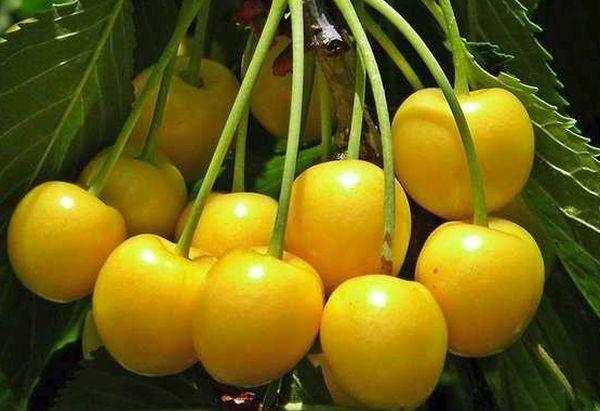
What diseases and pests are dangerous for the variety
The plant is susceptible to attack by harmful insects and diseases. The most common diseases are:
- Moniliosis.
- Coccomycosis.
- Fungal diseases.
The most common insects are:
- Black aphid.
- Cherry fly.
- Leaf rollers.
Landing features
The transfer of the tree to open ground should be carried out according to the terms, to a suitable place. It is important to respect the neighborhood of cherries, not all plants are suitable for this.
Recommended timing
The tree tolerates low temperatures well, so it is better to plant it for the winter. A favorable period for this is the end of September - early October. In the spring, planting is also carried out. To do this, you need to select a seedling before bud formation begins. It is important that all processes of the vegetative period take place after planting, this will strengthen the plant.
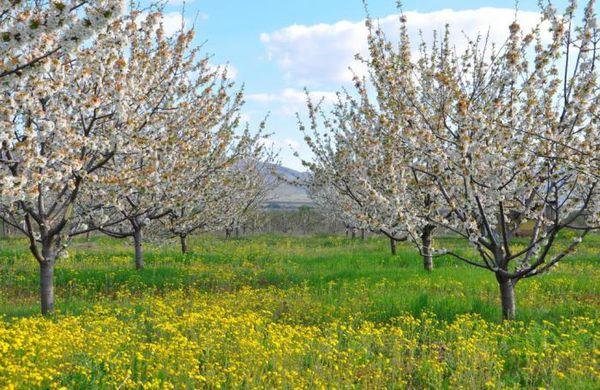
Choosing the right place
A place for cherries is chosen well-lit, with a minimum risk of flooding the tree, without drafts. The tree is unpretentious to soil fertility, the main thing is that it is light and well aerated. There should be no other trees closer than 6 meters near the plant. This reduces the yield of sweet cherries.
Suitable and forbidden cherry neighbors
Suitable for the neighborhood with cherries are:
- pear;
- apricot;
- other types of cherries;
- peach;
- gooseberry;
- raspberry;
- currant;
- grapes.
The tree grows poorly next to a plum, apple and cherry tree, you should not plant them nearby.
Seedling preparation
The seedlings are bought at garden markets. Most often they can be found in the autumn. It is better to choose trees without grafting, with good dense branches.There should be no damage, cracks, or scratches on the shoots. It is important to pay attention to the roots so that they do not rot. In the fall, they buy seedlings with fallen leaves, and in the spring with not yet swollen buds.
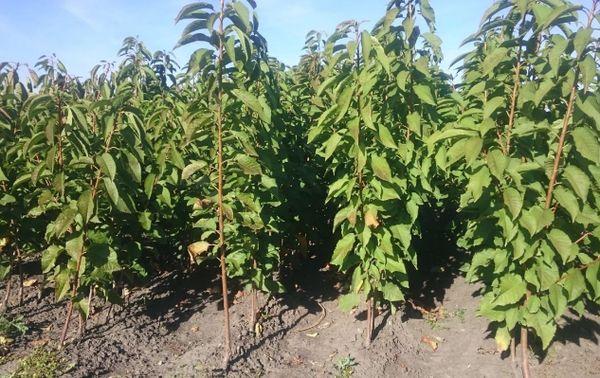
Important! Annual trees take root better than two and three year olds.
Disembarkation algorithm
Pre-prepare the soil. If it is clayey and heavy, it is mixed with sand. In an acidic environment of the earth, the plant does not take root well, therefore dolomite flour is added to the soil. Landing is carried out as follows:
- Dig a hole 60 cm deep and 80 cm in diameter.
- A tree stake is driven into it, which in the future is tied to a seedling in order to protect it from strong winds.
- Part of the excavated soil is mixed with humus, potassium mineral fertilizers and superphosphate are added.
- The roots of the seedling are straightened, the damaged areas are cut off.
- Placed in a pit.
- Sprinkle with soil mixed with fertilizers on top.
- Sprinkle with soil in layers, after which each of them is tamped so that there is no space with air.
- Pour 10 liters of water into the pit.
Important! Sprinkle the roots with half of the soil dug from the pit, so that a depression remains around the trunk.
Proper crop care
In order for the culture to grow correctly, develop well and give a lot of harvest, it is necessary to follow the rules of caring for it. With improper care, the yield of sweet cherries decreases.

Watering and loosening the soil
The plant does not really like increased moisture. Cherries are watered every 2-3 weeks with water in a volume of 10 liters. With the onset of drought, irrigation is increased up to 1 time per week. To determine if the tree has enough moisture, you need to check the soil near the trunk circle. If it is dry, then there is little moisture, if it is wet, there is enough. The plant does not tolerate waterlogging of the soil.
Loosening of the soil is carried out after each watering and rain. At least once a week, as the tree loves airy soils.
Top dressing
In the spring, fertilizing is carried out with nitrogenous fertilizers, in the middle of summer - with complex compositions, before wintering - with phosphorus and potassium fertilizers. To strengthen frost resistance, fertilize with complexes with sodium content.
Pruning
In the first year after planting, cherries must be pruned. After transferring to the ground, the central conductor is cut off. This is done to form a lush crown and reduce plant growth. After germination of new shoots, they are pruned again. Until a three-tiered crown is formed. Older trees are pruned every year, thinning dry branches and dense areas to make it easier for fruits to stick to the branch.
Diseases and pests: control methods and prevention
Sweet cherries require regular processing from pests and diseases. If it was not possible to prevent the disease, then you need to get rid of it as quickly as possible. If this is not done, the plant will not bear fruit, and in the worst case, it will die.
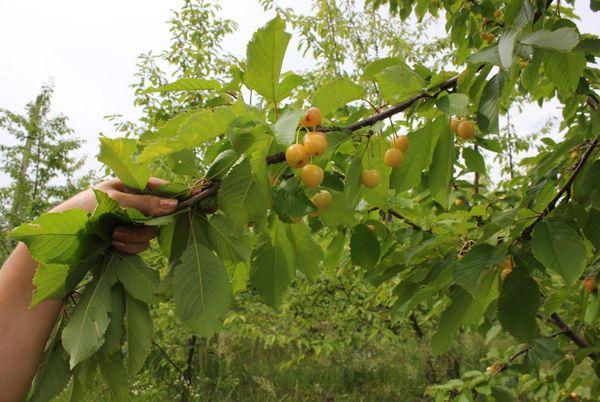
The most common diseases affecting the tree:
- Moniliosis. The shoots begin to dry, leaves fall from them, rot forms inside the branches. You can only fight this problem by cutting off the branches. In the place of the cut, a garden var is applied. For prevention, the cherry bark is coated with whitewash every year.
- Coccomycosis. Dark red spots form on the foliage. The leaves gradually turn yellow and fall off. Treatment for this disease is carried out during the period of bud formation and flowering. Bordeaux solution is used.
- Fungal formations. They appear on the bark of a tree, they are yellow, gray, blue, black. When growths are formed, they are cut out and the place is treated with garden pitch. Pieces of growth are burned outside the garden.
Also, cherries are affected by harmful insects that feed on its leaves and fruits. Major insect pests:
- Black aphid. They are located on the bottom of the sheet in the form of black film. Leaves are eaten, which gradually turn yellow and fall off.Insecticides are used to combat them. To avoid an attack, it is recommended to spray during the period of bud formation.
- Cherry fly. The most dangerous enemy of cherries. These flies lay larvae on tree branches, which actively feed on fruits. It is quite difficult to deal with them. Set up tree traps, painted bright yellow. After it has worked, the insects are destroyed. At the same time, the leaves of the tree are treated with the "Confidor" solution.
- Leaf rollers. They feed on the leaves of the plant. After which the leaves turn yellow, fall off, and the quality of the fruit will deteriorate. To combat them, the tree is sprayed with a chloroform solution. For prevention, the procedure is carried out twice, in preparation for winter and during the formation of the kidneys.
Shelter from frost
The tree has good frost resistance. However, it is recommended to cover young trees with completely warm fabrics for the winter. Their frost resistance appears only by the 3rd year of the growing season. For mature trees, moss is laid around the trunk for the winter to ensure their safety.
Important! Synthetic fabrics are not suitable for shelter for the winter.
Reviews
Oksana, 45 years old, Moscow: “I have long wanted to try to grow the variety of Rossoshanskaya golden sweet cherry. This year I bought a seedling with a pollinator. My earth is clay, so I mixed it with sand. Planting was carried out in the spring. By the middle of summer, the first buds appeared. I pruned to the third tier. The tree grows rather quickly, by the end of the season its height has increased by almost a meter. "
Alexander, 59 years old, Chekhov: “I planted the Rossosh golden cherry 8 years ago. I bought it on the market. Planting was carried out for the winter, took root well. It gives a lot of fruits, they are sweet, juicy, large. I planted a tree next to a pollinator. In the fourth year of life, she began to bear fruit. Every spring I carry out treatment against pests, while I have not been sick with anything. We have good dry soils, we are not worried about watering. Once I didn't irrigate for a month, but she still gave a good harvest. "
